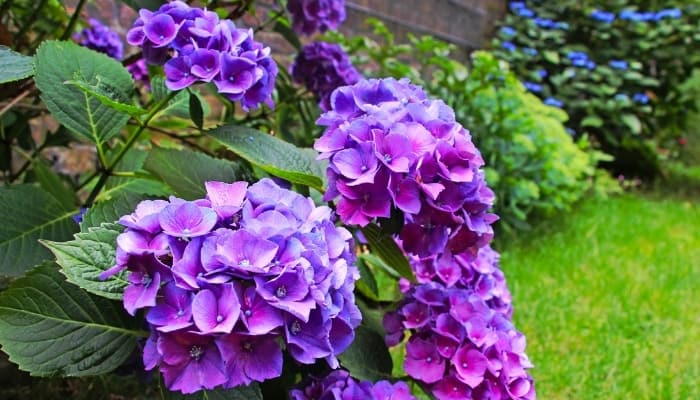Hydrangeas are considered one of the top flowering shrubs due to their exceptional features. Their stunning blooms, attractive foliage, and charming English cottage aesthetics make them a coveted addition to flower gardens.
They will also tolerate a variety of different moisture levels and soils, and they tend to be resistant to disease and pest insects.
However, the right plant identification and maintenance is often overlooked, and gardeners may not see the full, intense blooms due to incorrect pruning methods.
Will hydrangeas bloom after cutting? Pruning hydrangeas is not necessary and will not force the plant to bloom again as most varieties bloom only once each year. Hydrangeas that bloom on new wood can be pruned in very early spring. Those that bloom on old wood can be pruned right after flowering without affecting the next season’s blooms.
Caring for hydrangeas can be a tricky business, and there are nuances that gardeners must know to keep these flowering shrubs in their best condition.
In the following, you’ll learn the most critical considerations and find useful tips so that you can enjoy year after year of spectacular blooms.
Cutting Hydrangeas – What To Know
It is important to understand what exact type of hydrangea you are growing so that you can give it the care that it needs. New and old wood varieties differ in their pruning needs.
If you are unsure which of these two you have growing, local nurseries will usually be happy to identify which variety it is if you bring them leaf and flower samples.
Should I Deadhead Hydrangeas?
Deadheading hydrangeas is a commonly practiced method for keeping plants looking vigorous and healthy. It is not necessary, but many gardeners prefer to tidy up their plants after blooming.
There are a few caveats, however, so keep reading to find out how to deadhead these shrubs.
Does Cutting Hydrangea Flowers Hurt the Plant?
Removing flower heads from hydrangeas actually allows the plant to direct energy into growing and producing strong healthy leaves and new growth, so think of this as a beneficial practice in caring for your plants.
When Should I Cut the Flowers Off My Hydrangea?
Pruning flowers from your hydrangea can be undertaken throughout summer and early fall. Some gardeners prefer to leave dried blooms on the plant, whereas others will take them off completely.
Do Hydrangeas Need To Be Cut Back for Winter?
No, hydrangeas do not require cutting back in preparation for winter. Even spent blooms may add to the beauty of a winter garden.
Will Hydrangeas Grow Back if Cut Down?
Yes, hydrangeas do recover and grow back after intense cutting. Some gardeners even opt to cut shrubs back to the ground. Just remember, however, that while this will give you a strong plant, flowers on old wood hydrangeas will skip a blooming season.
Best Time To Prune Hydrangeas
New wood hydrangeas need to be pruned in late winter or early spring before the plant has left dormancy. This is because new growth varieties will produce all their blooms on new growth and will do so every season.
For old wood types, most gardeners rarely prune them at all and only do so to keep a tidy appearance or to trim any dead branches. If you must prune an old wood hydrangea, do so right after flowering.
When Is It Too Late To Cut Back Hydrangeas?
Technically, it is never too late to cut back hydrangeas; however, you should avoid pruning in the fall.
Pruning Hydrangeas in the Fall
Pruning in fall is not necessary for any type of hydrangea. In areas that receive snowfall, removing spent blooms may be a good idea, however, as this will prevent any potential damage from the weight of snow breaking healthy stems.
How To Deadhead Hydrangeas
To correctly deadhead hydrangeas, follow the flower stem and cut away about a quarter of an inch just above the new buds on the stem. This diagram is a great example of the correct deadheading technique.
Tips for Pruning Hydrangeas
Keeping an alcohol-soaked cloth on hand makes it easy to wipe your shears as you go. Utilizing bypass shears, such as these, will also give you clean cuts, which the plant can easily recover from.
Less is more when it comes to old wood hydrangeas, and they will happily grow and give you abundant blooms if left mostly undisturbed.
Types of Hydrangeas and When To Prune
Old wood hydrangea varieties are great for gardeners who enjoy planting and forgetting as they will grow steadily and produce blooms year after year. Deadheading will give you a tidy-looking plant but is not strictly necessary.
New wood varieties, on the other hand, will bloom from growth developed that same year, so to keep good-looking and shapely plants, pruning in early spring every season is required.
Related Questions:
How Far Do You Cut Back Hydrangeas?
Hydrangeas can be cut back all the way to the main stem. This can be good practice to encourage growth in older plants, promote healthy root systems, and spur vigorous canopy growth.
Just remember you sacrifice a blooming season for this method.
How Long Do Dried Hydrangeas Last?
Dried hydrangeas are a real treat to use as flower displays and make great gifts as well. If undisturbed, dried flowers are known to last for up to a year.
Conclusion
It can be a daunting task to find exactly how to care for your hydrangeas, and there is a ton of information out there, which can get a little confusing.
Just remember that in most cases, less is more, and simply deadheading plants is a safe practice for all varieties of hydrangeas. It is also important to leave cutting for early spring and to sanitize all your equipment.

